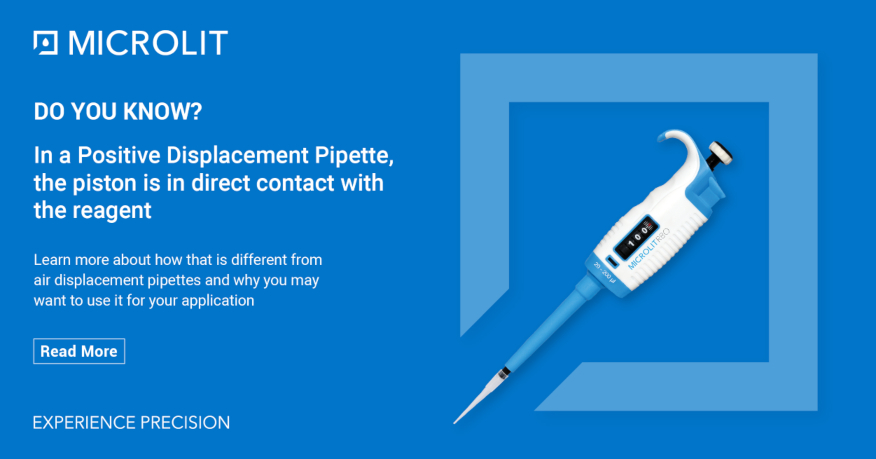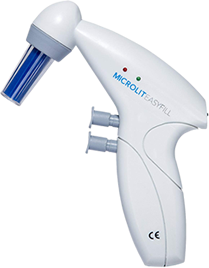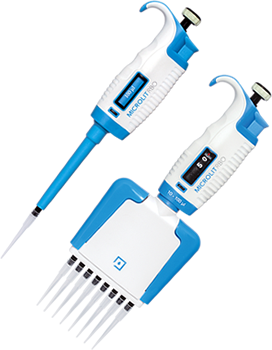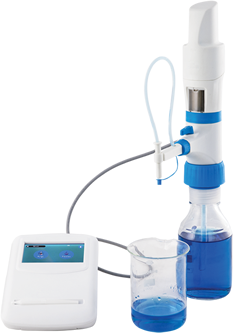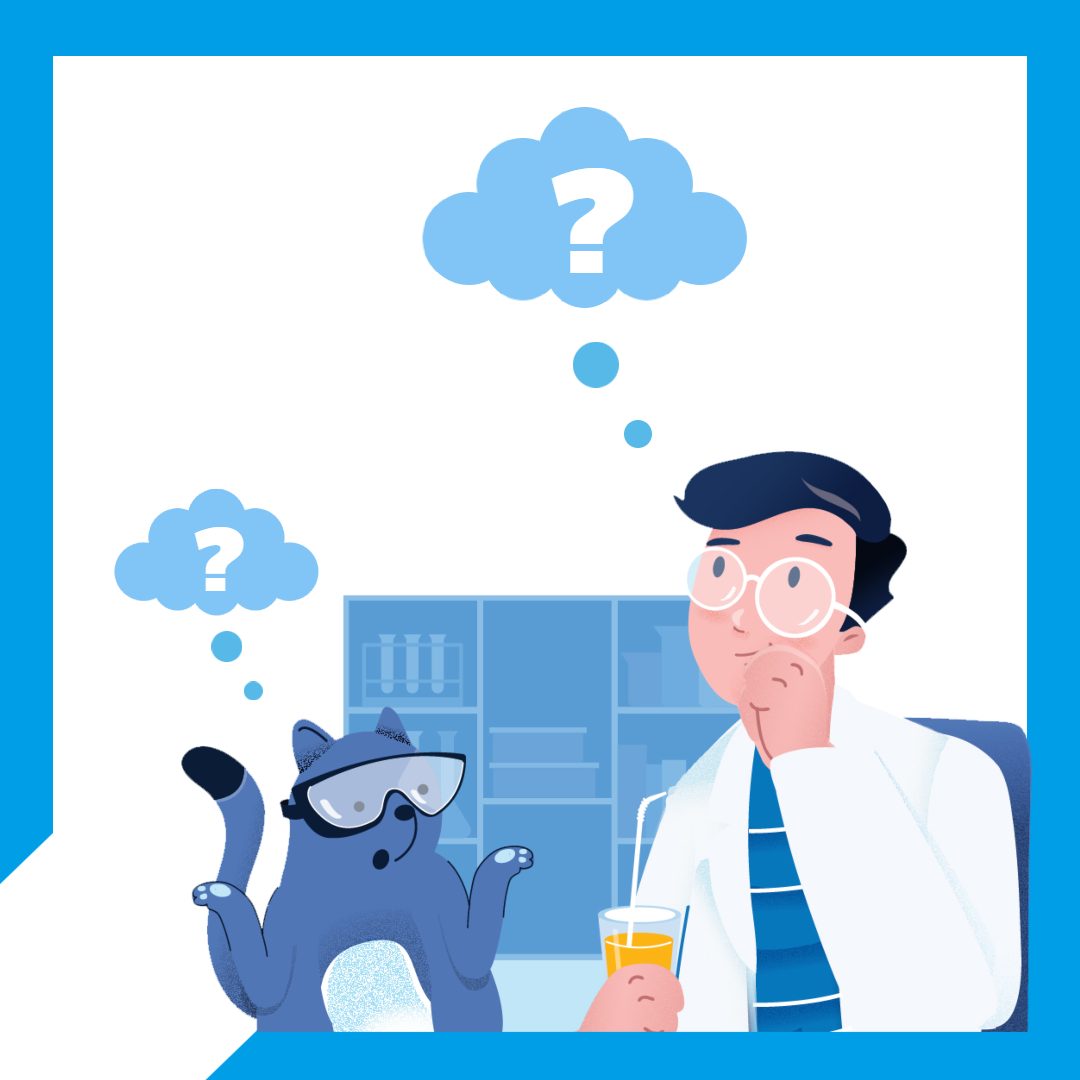Mechanical displacement pipettes have been in use across a gamut of laboratory / scientific research applications for more than 50 years. These pipettes are user-friendly, and can be used to dispense a variety of liquid formulations. The working principle of a displacement pipette is straight-forward. The push button on the pipette is pressed, and the pipette’s piston makes the liquid move under the action of an air cushion, also known as dead volume. The volume of the liquid aspirated is equivalent to the volume of air displaced.
There are basically two types of displacement pipettes- 1) Air Displacement Pipettes, 2) Positive Displacement Pipettes. The operating principle for both these types of pipettes is almost the same, however, in a positive displacement pipette, the air cushion between the piston and the aspirated liquid is absent, and the liquid is in direct contact with the piston’s surface. The subsequent section discusses the basic working principles of air-displacement and positive displacement pipettes, as well as key differences between the two.
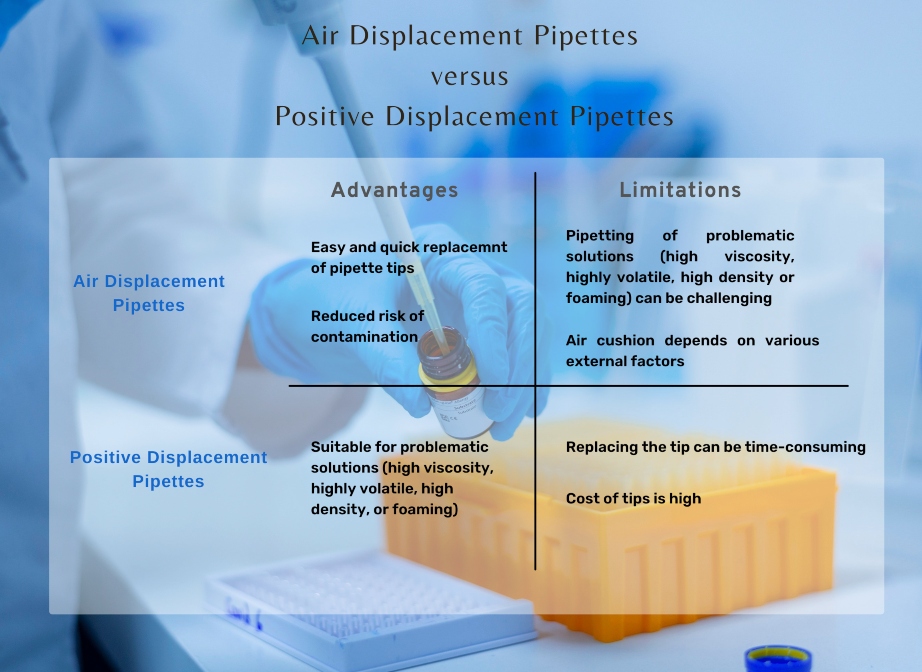
Air Displacement Pipettes
In an air displacement pipette, a small air cushion exists between the piston and the liquid solution during the process. It is an extremely accurate equipment for a wide range of standard pipetting applications. However, various parameters, including temperature, atmospheric pressure, viscosity and density of the liquid significantly affect the performance of an air displacement pipette.
- Temperature: The most crucial factor affecting pipetting accuracy is the temperature of the liquid being dispensed. When the temperature of the pipette’s surface, air and the liquid is comparable, the accuracy of pipetting is not significantly affected.
- Density: A liquid’s density impacts the amount of liquid dispensed by the pipette, as a highly dense liquid exerts an increased force on the air cushion present between the piston and the liquid solution. This makes the air space to stretch, leading to a smaller amount of liquid being aspirated into the tip.
Using an Air-displacement Pipette
Aspirating the Liquid
- Calibrate the piston with the desired volume in order to move it to the accurate position.
- After the operating button is pressed, the piston ejects the same amount of air as specified in the volume settings.
- The operating button is released when the tip is immersed into the liquid, creating a partial vacuum, and aspirating the indicated liquid volume.
Dispensing the Liquid
- After the operating button is pushed to the first stop, the air expels the liquid. In order to completely eject the sample from the tip, the button is pressed again to a second stop.
An air displacement pipette is generally used to dispense small amounts of aqueous / non-viscous liquids in general laboratory work with high accuracy. These pipettes enable contamination-free liquid handling, as well as allow for an easier replacement of pipette tips.
Positive Displacement Pipettes
On the other hand, in a positive displacement pipette, there is no air present between the piston and the liquid, therefore, the piston’s surface is directly in contact with the liquid. This happens because the piston is not integrated inside the pipette, but is held within specialized disposable tips, also known as capillary piston (CP) tips. CP tips facilitate elimination of the air cushion present between the liquid and piston, which ensures that the pipetting accuracy is not compromised by any external factors. The absence of an air cushion greatly enhances the accuracy of the volume measured, which makes it easier to dispense highly viscous, volatile or hazardous liquid samples. The volume of aspirated liquid is dependent on the dimensions of the capillary. Using a disposable capillary piston also helps in minimizing contamination as it is in direct contact with the sample, thereby protecting the pipette surface as well as the user.
Using a Positive Displacement Pipette
Aspirating the Liquid
A positive displacement pipette makes direct contact with the liquid, therefore, the piston moves down inside the tip in order to draw the liquid into it.
Dispensing the Liquid
As the piston descends, the indicated volume of liquid gets dispensed.
A positive displacement pipette is suitable for pipetting high density / viscous solutions, such as fats, protein solutions, resins, oils, volatile liquids, foaming liquids or any other problematic liquid solutions. The downside of using a positive displacement pipette is the high cost of pipette tips, as well the cumbersome process of replacing the tips from time to time.
Choosing the Right Displacement Pipette
Selecting the right kind of displacement pipette for your needs can be confusing, especially due to the availability of a variety of pipette models in the market. In order to choose the optimal pipetting equipment, you need to evaluate the fundamentals of the liquid samples you usually work with.
In addition to accounting for different properties of the liquid sample, the volume range of the sample also needs to be considered while choosing an appropriate pipette. For instance, only certain pipette types are available in small volume ranges, and are therefore preferred for experiments requiring higher precision.
Further, various other requirements pertaining to the specific pipetting application are taken into considerations, such as frequency of dispensing the liquid, type of vessels / containers used, as well as the extent of experience of the lab personnel handling the pipette. It is crucial that the chosen pipette is intuitive to operate, precise and poses lower risk of contamination.






 24037
24037